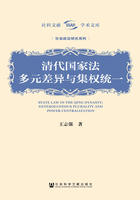
Abstract
In State Law in the Qing Dyrasty: Heterogeneous Plurality and Power Centralization, Wang Zhiqiang describes the geographical and structural differences in the laws of the Qing dynasty, and the gap between law legal codes and legal practices. Furthermore, Wang offers an explanation for these from the perspective of political power structure.
In Qing legislation, central authorities set up special rules for different regions, making laws in the land pluralistic. Meanwhile, at times inconsistent with the law of the central government, local legislations were similar to one another in some aspects but dissimilar in some others. In the field of law enforcement, judicial opinions and styles were diverse among different people and organization. In hard cases, While judicial officials often deviated from the logic of causality and literal interpretation of the law, they nonetheless insisted on citiug directly from the law. Appeal to precedents, which had clearly been prohibited, was however widely used in practice.
Compared to those in a modern society, Wang argues, regional, structurel and practical differences in the law had their distinct features in imperial Qing. Wang attributes the haterogeneous plurality of legislations and legal practice in the Qing Dynasty to the highly centralized political power system, under which tension can arise between centralized governance and the reality officials at different levels of government face in terms of power, resources and cases.